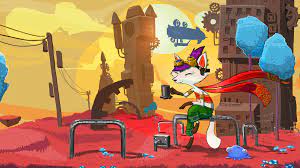Project Description
 Follow the online Unity tutorial to create a game using the Ruby’s Adventure. The tutorials covered include
Follow the online Unity tutorial to create a game using the Ruby’s Adventure. The tutorials covered include
- Player Character and Movement
- Set up a 2D player character
- Create a basic 2D gameplay environment
- Read keyboard input to control 2D character movement
- Create Input Actions for player character movement
- Make your game frame rate independent
- Game Environment and Physics
- Design and paint your game tilemap
- Create decorative objects using sprites
Your game must include:
- Main Character – Ruby
- Moves under keyboard control.
- Moves smoothly.
- Interacts with the world and other objects.
- Word Design
- A world of 50 x 50 has been created.
- A variety of tiles have been used to create the world.
- A Tilemap has been made with all the floortiles in the tutorial
- Tiles have been ordered properly.
- Certain tiles are colliders that will interact with Ruby.
- Decorations
- The world has at least 10 decorations.
- At least 3 types of decorations have been used.
- At least one decoration collides with Ruby properly.
- Box colliders resized properly
- Game Mechanics
- Ruby moves in a logical and easy way.
- The tiles and decorations create a world that is easy to move around.
- Game Dynamics
- Interactions between Ruby and the world (tiles and decorations) are logical and easy to follow.
- Game Aesthetics
- The level is a more of a tutorial on how to work the game mechanics.
- The game has a medium to low difficulty level.
- Playing the game is enjoyable and you want to see what comes next.
Rubric
Grade / Topic | A | B | C |
|---|---|---|---|
Main Character (Ruby) | Moves smoothly Moves vertically and horizontally Interactions are smooth. | Movement is OK, but could be improved. Interactions are OK, but could be improved. | Movement is not smooth and rotates. Does not move properly in one direction. Interactions are not consistent or existent. |
World Design | A world of 50 x 50 has been created. At least 15 tile types have been used. A Tilemap has been made with all the floor tiles in the tutorial. Tiles have been ordered properly. Certain tiles are colliders that will interact with Ruby. | A world of 40 x 40 has been created. At least 8 tile types have been used. A Tilemap has been made with most of the floor tiles. Tile order is good, but could be better.
Certain tiles are colliders but don’t interact with Ruby properly. | A world of 50 x 50 has been created. At least 4 tile types have been used. A Tilemap has been made with a few of the floor tiles. Tile order is confusing. Certain tiles are colliders but don’t interact with Ruby. |
Decorations | At least 10 different decorations have been added. At least 3 different decoration types have been added. At least one decoration is a prefab. | At least 5 different decorations have been added. At least 2 different decorations types have been used. At least one decoration is a prefab. | At least 2 different decorations have been added. Only 1 decoration type has been used. Prefabs are not used. |
Game Mechanics | Ruby moves in a logical and easy way. The tiles and decorations create a world that is easy to move around. | Ruby moves in a fairly logical and easy way. The tiles and decorations create a world that is easy to move around. | Ruby does not move in a logical and easy way. The tiles and decorations create a world that is not too easy to move around. |
Game Dynamics | Interactions between Ruby and the world (tiles and decorations) are logical and easy to follow. | The game dynamics can be a little confusing. | The game dynamics are confusing. |
Game Aesthetics | The game is not too easy and not too difficult. Playing the game is enjoyable and you want to see what comes next. | The game is a little too easy or too difficult. Playing the game is a little frustrating, but you want to see what comes next. | The game is too simple or really difficult. Playing the game is too easy or too difficult. You don't care what comes next. |